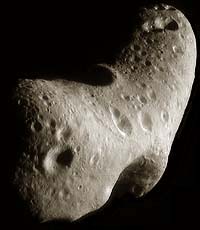 NEAR Shoemaker Has Eros Covered
NEAR Shoemaker Has Eros Covered
|
Laurel - July 1, 2000 - To NEAR Shoemaker's digital camera it was merely another sequence of images. But the photos of Eros' south pole snapped in the early hours of June 27 will give NEAR team members the last pieces of a global puzzle, covering the only ground on Eros they haven't seen since the satellite began orbiting the asteroid on Feb. 14.
"We're filling in the last little gaps," says Louise Prockter, a member of the NEAR imaging team at the Applied Physics Laboratory. "Once we process those images, we will have everything we need for a global mosaic of Eros."
It's autumn in the asteroid's northern hemisphere, which means the sun is illuminating the southern regions that were shadowed through the first months of NEAR Shoemaker's orbit. The camera couldn't "see" the areas earlier because it needs reflected light from the surface, so most of the imaging covered the northern sections.
Now that it has a overall view of Eros, the NEAR team can start to train the camera on specific details among the asteroid's craters, ridges, grooves, boulders and troughs. "Every day we see new structures," Prockter says. "We have seen an incredible variety of amazing features, and we are recognizing things we've seen on other terrestrial planets and bodies. "
The NEAR team gets its closest look yet at those features on July 14, when the spacecraft begins a 10-day, nearly circular orbit just 22 miles (35 kilometers) from the asteroid's surface. NEAR Shoemaker descends from its current 31-mile (50-kilometer) vantage on July 7. The spacecraft is 74 million miles (118 million kilometers) from Earth, circling Eros at just under 7 miles an hour.
|

Photo's like this will be available on demand from the Eros Atlas in a year or so. Desktop available here JHUAPL Image |
Near-Earth Asteroid Sample Return Workshop
Washington - July 1, 2000 - It is widely recognized that comet, asteroid, and meteorite research is at a point in its history where sample return from a known geologic context is essential, and several past workshops have stressed the need for such missions.
Near-Earth asteroids (NEAs) are also important as potential Earth impactors, targets for human exploration and development of space (HEDS), and resources for space stations and colonies.
Several developments in the last year or so mean that it is now technically feasible to fly NEA sample return missions. The NEAR Shoemaker mission demonstrated the feasibility of orbiting and performing complex maneuvers near small asteroids.
The Deep Space 1 mission validated solar electric propulsion and automatic navigation. Most important, the explosion in the rate at which NEAs are being discovered means that targets of diverse spectral classification, including some that might be extinct comets, come within range of a multiple NEA sample return mission. The Japanese MUSES-C mission, which will return samples from asteroid ML 1989, is scheduled for launch in 2002.
Get the details
|
Copyright 2000 AFP. All rights reserved. The material on this page is provided by AFP and may not be published, broadcast, rewritten or redistributed.
SOLAR TRASH
 New Study Plots 900 NEOs
New Study Plots 900 NEOs
Ithaca - June 22, 2000 - A new study portrays the paths of asteroids in the inner solar system as a vast Los Angeles-style traffic system crisscrossed with superhighways along which are hurtling huge, rocky projectiles. And in the middle of the highway network, on a possible collision path, is the planet Earth.
Thanks for being here;
We need your help. The SpaceDaily news network continues to grow but revenues have never been harder to maintain.
With the rise of Ad Blockers, and Facebook - our traditional revenue sources via quality network advertising continues to decline. And unlike so many other news sites, we don't have a paywall - with those annoying usernames and passwords.
Our news coverage takes time and effort to publish 365 days a year.
If you find our news sites informative and useful then please consider becoming a regular supporter or for now make a one off contribution. |
SpaceDaily Contributor
$5 Billed Once
credit card or paypal
|
 |
SpaceDaily Monthly Supporter
$5 Billed Monthly
paypal only
|
|
 |
|

 New Study Plots 900 NEOs
New Study Plots 900 NEOs